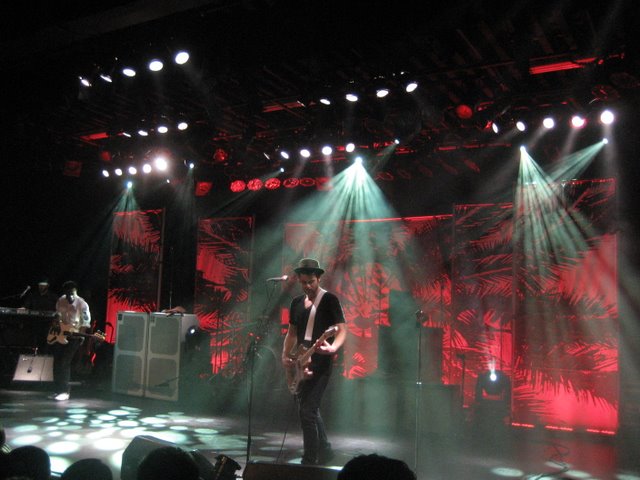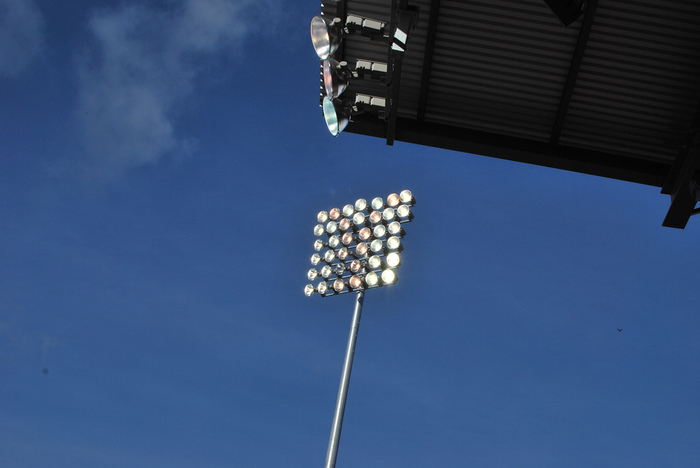Chapter 1 - The Rootsystem
Chapter 2: The Loud Loudwest
Chapter 3: Sax And The City - All That Jazz
Chapter 4: Rebeltown - Punk Rock’s Angry Enclaves
Chapter 5: Van-clover - The Celtic Scene
Chapter 6: Bowties And Ballgowns - The Elegant Nights Out
Chapter 7: Smoky Coasts - The Best of Pacific Blues
Chapter 8: Viva la Van - Salsa Beats in Vancouver
A Brief History of the Vancouver Music-Scene
Musical entertainment has been in Vancouver’s veins since the city’s early days as a burgeoning fishing and lumbering town. From Gastown’s first saloons to punk rock’s last enclaves, this city’s history can be told better in song than in words. Even Lulu Island, the geographical name for the suburb of Richmond, was inspired by the then Mayor of Vancouver’s showgirl paramour, Lulu Sweet. Much water has passed under the Burrard Street Bridge since then, but the love affair, it would seem, has continued.
 Vancouver Folk Festival by Astroguy
Vancouver Folk Festival by Astroguy
There was a time when the now-derelict stretch of Hastings Street between Main and Cambie was a neon-lit stretch of theatres, clubs and restaurants known as ‘The Great White Way’. It was home to such legendary establishments as The Beacon Theatre, The Lux Theatre and The Pantages of the famous continental theatre chain. A young and vibrant array of both professional and amateur companies was producing world-class shows, and venues like The Vogue, The Strand and The Coronet were fast becoming popular landmarks also.
But something was developing across town…
The Canadian Pacific Railway (CPR) was on the main route from London to the Far East and the railway company’s property division wanted to attract commercial life away from the older part of the city. Attached to the CPR’s Hotel Vancouver was a neo-Egyptian styled opera house on Granville Street called the Orpheum Theatre. Eventually renamed the Lyric Theatre, it soon established itself as the hub of Vancouver’s nightlife. As a result, stores and other theatres began to open in the area, birthing the strip once known as Theatre Row and now commonly recognized as The Granville Entertainment District.
Today, the Orpheum name lives on in the restored vaudeville house one block further down the same street.
 Almost Empty Theatre by Kevin
Almost Empty Theatre by Kevin
As prohibition ended, the 1920’s and 1930’s saw entertainment flourish. Vancouver became a destination point on the worldwide circuit know as the Grand Tour, which included clubs in Cairo, London, New York, Paris, Rome, San Francisco, Shanghai and Sydney.
During this time, musical theatre thrived in its many forms, thanks in part to the Malkin Bowl in Stanley Park. The resident company, Theatre Under the Stars was a critical success for many years. Its successor in the 1970’s, Theatre in the Park was less popular, however a new company bearing the original name has recently re-established this unique institution in the city’s famous park.
The Grande Tour also brought jazz music to Vancouver relatively early. As the city became home to many of the black customer-service employees of the CPR, an eastside shantytown known as Hogan’s Alley began to develop. Despite its slum reputation and continual police interference, this neighbourhood’s underground music clubs incubated some of the finest session musicians in the country.
It seemed that the era’s stringent liquor and entertainment laws did little to quell Vancouver’s booming nightlife. Several high-end dinner clubs opened, the most notable being The Cave. For years, this Hornby Street haunt with its stalactite decor was a mecca for high society. Only in later years were black musicians allowed to play in the house bands of such clubs. But as racial tolerance evolved, so did the music. Before long, the city was becoming home to a solid and influential community of blues, funk and soul merchants. Many greats have hung their hats here, including Long John Baldry, Koko Taylor, Randy Bachman and Lovena Fox.
Other ethnicities influenced what was fast becoming Vancouver’s music culture. Chinatown’s benevolent associations had their own private orchestras and Chinese opera enjoyed great popularity. Ukrainian folk dance troupes performed regularly. Bagpipes were a familiar sound in the Scottish neighbourhoods. And one had to go only as far as Greektown or the Italian District to experience the Pacific’s version of the Mediterranean.
 A night at The Commodore - by Kyle Pearce
A night at The Commodore - by Kyle Pearce
Commercially speaking, the 1940’s saw a new kind of music taking the scene and attracting club-goers in droves: Ballroom. And nothing sparked the vitality of the new generation quite like swing dancing. The boisterous sounds of Big Band boomed from any number of hotel ballrooms almost nightly. At the centre of the maelstrom stood The Commodore Ballroom, playing host to some of the biggest swing bands of the period including the likes of Dal Richards and Mart Kenney. Slowly, Vancouver’s youth culture was emerging. During the Commodore era, people went out for the joy of dancing to fine music.
Over the next decade, modern music made steady inroads while simultaneously, classical music matured. Founded in 1958, The Vancouver Opera was conceived by a group of visionary community leaders who saw need for a permanent company to enrich the growing city’s cultural centre. Today, VO is the second largest opera company in Canada.
By 1960, swing was only a memory, but a new generation of youth were challenging the status quo. They were driven by malcontent and fuelled by ideals. And as they were finding themselves, social change was finding a soundtrack. A soundtrack that was gestating in clubs like Davie Street’s Retinal Circus and Rohans Rockpile in Kitsilano. This, Vancouver hippie scene, featured such psychedelic acts as United Empire Loyalists, Moby Duck and Mother Tucker’s Yellow Duck.
 Lights at Empire Stadium by Karen Neoh
Lights at Empire Stadium by Karen Neoh
Simultaneously, the rock’n’roll revolution was in gear. East Vancouver’s Empire Stadium hosted mega-stars like The Rolling Stones, The Beatles and even Elvis. This outdoor venue catered not only to the enormous crowds, but also to the city’s nervous conservative populace who were relieved to keep this volatile music and its followers away from the city centre. Eventually, Vancouver fostered its own rockers such as Bachman-Turner Overdrive, Loverboy and Trooper. Even visiting acts like Van Halen and Mötley Crüe made Vancouver their occasional home while recording.
Another genre that flourished on the shoulders of the 1970’s was folk music. The coffeehouse culture nurtured the likes of Valdy and Pied Pumpkin who continued on to great success in the burgeoning festival culture. Today, The Vancouver Folk Festival is world renown and one of many festivals to grace the city’s beaches and parks every summer.
As the 1980’s approached, an anarchistic rumble from England gained momentum and culminated in a West Coast wave of loud, aggressive musical expression called punk rock. Empowered by the London scene, Vancouver’s punk had no problem elbowing into the spotlight. From Yalestown’s warehouses to hallowed venues like The Town Pump, The Starfish Room and the famous Smiling Buddha Cabaret, this subculture rose defiant, pierced and tattooed, demanding to be heard. Influential domestic acts such as Braineater, DOA, Subhumans and The Modernettes put the city permanently on the international punk rock radar.
 NoMeansNo by mjorgen
NoMeansNo by mjorgen
The following years saw the rapid evolution of genres and subgenres as Vancouver began to musically mature. From Spirit of the West’s easy folk-rock to the dark industrial sounds of electro-goth sensations Skinny Puppy, evidence everywhere pointed to change. The alternative movement spawned acts like Animal Slave and Nomeansno. With the 1990’s came grunge as Vancouver played little brother to Seattle, producing such bands as The Riff Randles, Gob and The Evaporators. On counterpoint, pop produced commercial ventures like Econoline Crush and Matthew Good.
With the birth of pop-punk came a stable of homegrowns like Kid Icarus or Submission Hold. Hardcore heavyweights such as bands like A Javelin Reign and The Attack began tipping the scales. Metal found itself born anew in Three Inches of Blood.
Yet, despite its eclectic array of genres, modern Vancouver has established itself globally as an Indie city with mod ambassadors such as The New Pornographers, Hot Hot Heat and You Say Party! We Say Die!, playing to sold-out crowds worldwide.
As testament to the city’s perpetual growth as a musical entity, a recent small yet respected hip-hop community has muscled into the scene and onto the charts with outfits such as Swollen Members, Social Deviantz, Sweatshop Union and Moka Only.
Truly, Vancouver is one of the most culturally diverse metropolises in the world. All you have to do is listen…
Chapter 3: Sax And The City - All That Jazz
Chapter 4: Rebeltown - Punk Rock’s Angry Enclaves
Chapter 5: Van-clover - The Celtic Scene
Chapter 6: Bowties And Ballgowns - The Elegant Nights Out




Thanks for the commentaries on the bearded ones of ZZ TOP, that great show in Austin Texas?
I liked to appreciate the musical performance of Vancouver a city that I appreciate very.
In the era when the Cave was the hottest place in town, There was a club on Georgia, I think, in the 70’s, Buddy Rich and his band played there in 1973. Can you find the name of the club, been trying to remember it for years.
thanks
That was Izy’s nightclub. I heard Jimmy Smith there a thousand years ago.
The club on Georgia that Glen is asking about was probably Isy’s Supper Club. It brought in top-rank acts for many years, rivalling the top-rank acts of the Cave and the Marco Polo.
the Club on georgia was Iay’s supper club.
We had some of the top acts to play Vancouver
cave was a larger room and could bring in a bigger
Name act than Isy’s,but are acts were as good as the Cave.Marco Polo acts were on the next leavel.
As Isy 7 richard walters were the owners of Isy’s
this is the true story.Aug 18 2011
by Richard Walters
also your story that there was no blacks playing in house bands in the 40/50/60 is wrong,I was at
the cave from 1952-1959 and iSY’S From 1959-1968
If their had been a black player in Vancouver and
he was a top player he would have been in our bands.at that time in Vancouver their were few blacks.
Richard walters
Trying to remember what the name of the club that was on Davie just West of ….it also had another club in the basement….plessr help